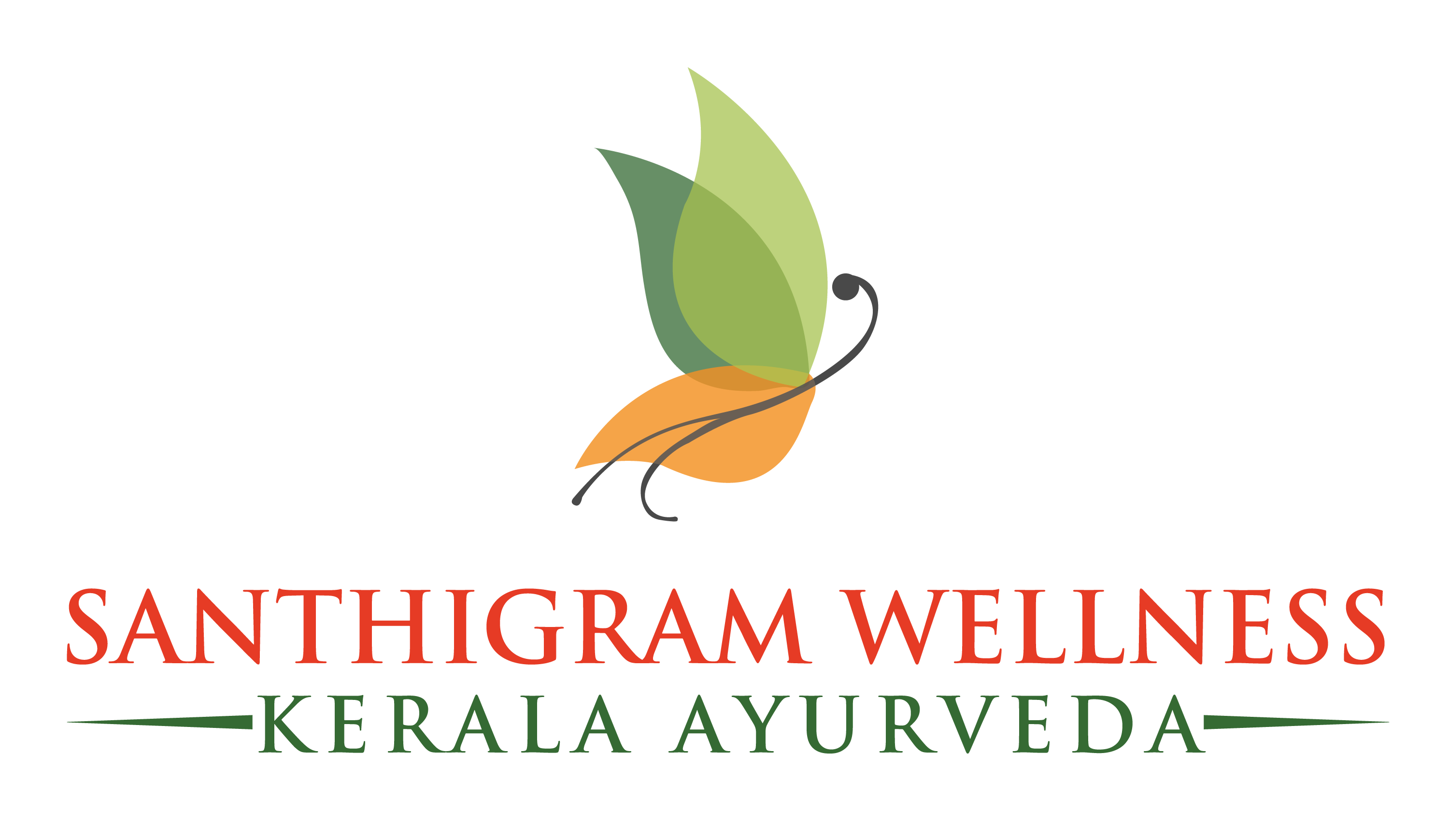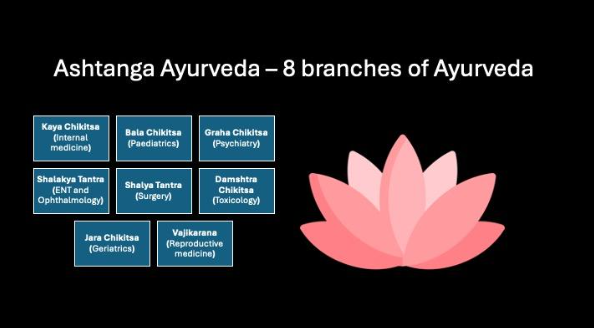Introduction to Ashtanga Ayurveda
Ayurveda, an ancient holistic health system, has its roots deeply embedded in India, dating back over 5,000 years. This traditional practice is not merely a form of medicine but a comprehensive approach to well-being, emphasizing the interconnectedness of the body, mind, and spirit. Derived from Sanskrit, the term “Ayurveda” translates to “the science of life,” underscoring its vast scope in promoting health and preventing disease through natural means.
One of the core concepts within Ayurveda is Ashtanga Ayurveda, which translates to ‘eight branches of Ayurveda1.’ These eight branches form a broad spectrum that collectively addresses all facets of health and well-being. They encompass various areas such as internal medicine, surgery, pediatrics, rejuvenation therapy, and even spiritual practices. Together, these branches offer a holistic framework that aims to maintain and restore balance within an individual.
Ashtanga Ayurveda’s integrative approach is distinctive in its emphasis on personalized care. It recognizes that each person has a unique constitution and health needs. By focusing on the balance of the doshas—Vata, Pitta, and Kapha—Ayurveda seeks to harmonize a person’s physiological, psychological, and spiritual elements. This balance is considered essential for achieving optimal health and preventing illness.
Moreover, Ayurveda’s holistic nature ensures that both physical and mental health are given equal priority. It combines dietary guidelines, lifestyle adjustments, herbal remedies, and therapeutic practices to create a well-rounded approach to health. Such an integrative method not only addresses existing health issues but also serves as a proactive measure to sustain long-term well-being.
In essence, Ashtanga Ayurveda represents a timeless system of holistic health that has stood the test of millennia. Its comprehensive and personalized approach continues to offer valuable insights into achieving and maintaining balance in the modern world.
Kaya Chikitsa (Internal Medicine)
Kaya Chikitsa2, or internal medicine, forms the cornerstone of Ashtanga Ayurveda. It focuses on the diagnosis, treatment, and prevention of diseases that affect the entire body. This branch utilizes a holistic approach, incorporating dietary adjustments, herbal medicines, and lifestyle modifications to restore balance within the body. The treatments aim to enhance the body’s innate healing capacity, addressing the root causes of illnesses rather than merely alleviating symptoms.
Bala Chikitsa (Pediatrics)
Bala Chikitsa3 is dedicated to the health and well-being of children. This branch emphasizes the unique physiological and psychological needs of growing individuals. Pediatric treatments often include herbal formulations, nutritional guidance, and preventive measures to bolster immunity and ensure proper growth and development. Bala Chikitsa also addresses common childhood ailments, thereby laying a strong foundation for lifelong health.
Graha Chikitsa (Psychiatry)
Graha Chikitsa, or psychiatry, delves into mental health and emotional well-being. This branch recognizes the intricate connection between the mind and body, employing therapies that include meditation, counseling, and the use of specific herbs to balance mental states. Graha Chikitsa aims to treat conditions such as anxiety, depression, and stress by harmonizing the mind and emotions. It achieves this through lifestyle changes4, ultimately promoting overall psychological resilience.
Urdhvaanga Chikitsa (ENT and Ophthalmology)
Urdhvaanga Chikitsa focuses on the head and neck region, encompassing ear, nose, throat, and eye health. Treatments in this branch include herbal formulations, nasal therapies (Nasya), and eye treatments5 (Netra Tarpana6) to address issues like sinusitis, hearing problems, and vision impairments. By maintaining the health of sensory organs, Urdhvaanga Chikitsa enhances overall sensory perception and quality of life.
Shalya Chikitsa (Surgery)
Shalya Chikitsa, or surgery, is one of the most advanced branches of Ashtanga Ayurveda and traces its roots back to the renowned Sushruta, known as the father of surgery7. It includes a wide range of surgical interventions, from minor procedures to complex surgeries. This branch also emphasizes pre-and post-operative care, incorporating Ayurvedic principles to support healing and recovery. Shalya Chikitsa highlights the integration of surgical techniques with holistic therapies to ensure comprehensive patient care.
Damstra Chikitsa (Toxicology)
Damstra Chikitsa specializes in toxicology and the treatment of poisoning8. It addresses various forms of toxicity, including snake bites, insect stings, and exposure to harmful substances. This branch utilizes detoxification methods, antidotes, and supportive therapies to counteract toxins and restore health. Damstra Chikitsa underscores the importance of timely intervention and the role of natural remedies in managing toxicological emergencies.
Jara Chikitsa (Geriatrics)
Jara Chikitsa9, or geriatrics, focuses on the health and wellness of the elderly. This branch aims to enhance longevity and quality of life through preventive care, rejuvenation therapies (Rasayana), and lifestyle modifications. Jara Chikitsa addresses age-related conditions such as arthritis, cognitive decline, and general debility, promoting healthy aging and vitality in the later stages of life.
Vrishya Chikitsa or Vajikarana (Reproductive Medicine)
Vrishya Chikitsa10, also known as reproductive medicine, deals with sexual health and fertility. This branch provides treatments for both male and female reproductive issues, utilizing herbal remedies, dietary guidance, and lifestyle adjustments. Vrishya Chikitsa aims to enhance reproductive health, address infertility issues, and support overall sexual well-being, thereby contributing to the continuity of life and family health.
Integrative Approach of Ayurveda for Holistic Wellness
Ayurveda, with its deep-rooted principles and methodologies, offers a profound integrative approach to holistic wellness. Central to this approach are the eight branches of Ashtanga Ayurveda, each focusing on a different aspect of health and well-being. By harmonizing these branches, Ayurveda provides a comprehensive framework for achieving and maintaining health.
The Ayurvedic philosophy revolves around the concept of balance, particularly the balance of the three doshas: Vata, Pitta, and Kapha. Each individual has a unique constitution, or Prakriti, which is a specific combination of these doshas. Ayurvedic treatments are meticulously tailored to align with this unique constitution, ensuring personalized care that addresses the root cause of imbalances rather than just the symptoms.
Natural remedies form a cornerstone of Ayurvedic treatment. Herbs like Ashwagandha, Turmeric, and Neem are commonly utilized for their healing properties. These remedies are often combined with dietary guidelines that emphasize the consumption of fresh, seasonal, and locally sourced foods, tailored to one’s dosha. For example, a Vata-pacifying diet might include warm, moist foods with sweet, sour, and salty tastes, whereas a Pitta-balancing diet would focus on cooling, mildly spiced foods.
Lifestyle practices such as yoga, meditation, and pranayama (breathing exercises) are integral to the Ayurvedic regimen. These practices not only aid in physical health but also promote mental clarity and emotional stability. Preventive measures, including regular detoxification and seasonal cleanses (Panchakarma), are employed to maintain balance and prevent the onset of diseases.
By drawing knowledge from its multiple branches, Ayurveda addresses complex health issues effectively. For instance, a holistic treatment plan for a condition like arthritis might incorporate Rasayana (rejuvenation therapy) to strengthen tissues, Shalya Tantra (surgery) for physical interventions if necessary, and Kaya Chikitsa (internal medicine) to manage chronic inflammation. This multifaceted approach ensures that every aspect of the individual’s health is considered, leading to more effective and sustainable outcomes.
In essence, the integrative approach of Ayurveda, with its emphasis on balance, natural remedies, and personalized care, offers a robust framework for holistic wellness, capable of addressing both simple and complex health challenges in a comprehensive manner.
Applications and Benefits of Ashtanga Ayurveda in Modern Life
Ashtanga Ayurveda, with its comprehensive approach to health, offers practical solutions to contemporary health challenges. In today’s fast-paced world, individuals can incorporate Ayurvedic practices into their daily routines to enhance overall well-being and manage stress effectively. For instance, simple lifestyle adjustments such as adopting a balanced diet, practicing yoga, and engaging in regular detoxification can have profound impacts on one’s health.
One of the major benefits of Ashtanga Ayurveda is its efficacy in managing chronic illnesses. Conditions like diabetes, hypertension, and autoimmune disorders can be better controlled through personalized Ayurvedic treatments. These treatments often include herbal remedies, dietary changes, and specific exercises tailored to the individual’s constitution. Research has shown that Ayurvedic interventions can reduce the severity of symptoms and improve the quality of life for those with chronic ailments.
Furthermore, Ashtanga Ayurveda addresses age-related conditions by promoting longevity and vitality. Practices such as Rasayana11 therapy focus on rejuvenation and maintaining youthful energy. This branch of Ayurveda employs various herbs and treatments to enhance mental clarity, physical strength, and overall immunity, making it a valuable tool for the aging population.
Stress is another prevalent issue in modern society, and Ayurveda offers effective strategies for stress management. Techniques such as meditation, mindfulness, and Pranayama (breathing exercises) are integral components of Ayurvedic practice that can significantly reduce stress levels and promote mental tranquility. Success stories abound, with individuals reporting marked improvements in their mental health and emotional stability after adopting these practices.
To ensure the effectiveness of Ayurvedic treatments, it is crucial to seek guidance from qualified practitioners. Look for certified Ayurvedic doctors and therapists who have undergone rigorous training. Additionally, numerous resources are available for those interested in further learning about Ashtanga Ayurveda, including books, online courses, and workshops. Embracing these ancient practices can lead to a harmonious balance of mind, body, and spirit in the modern world.
References
1. Kizhakkeveettil A, Parla J, Patwardhan K, Sharma A, Sharma S. History, Present and Prospect of Ayurveda. In: History, Present and Prospect of World Traditional Medicine. WORLD SCIENTIFIC; 2024:72. doi:10.1142/9789811282171_0001
2. Kalan K. Ayurveda Concept of Kayachikitsa and its role in the treatment of Vata Roga. wjpr. 2023;13(1):5. doi:10.20959/wjpr20241-30901
3. Pawar VS. Paediatric care through Ayurveda: A review study. wjpr. 2023;12(6):0.
4. Sharma N, Yadav Y, Sharma KC. Relevance of Ayurvedic concepts and lifestyle in promoting mental health. DPU’s Journal of Ayurved, Homeopathy and Allied Health Sciences. 2022;1(2):88. doi:10.4103/jahas.jahas_17_22
5. Bhardwaj DA. Netra Kriya Kalpa – A Critical Review. Journal of Ayurveda and Integrated Medical Sciences. 2019;4(02):121-125. doi:10.21760/jaims.v4i02.608
6. Kumar M, Bhatnagar V, Bochalya A, Kumawat N, Gumber T. Netra Tarpana: An Ocular Therapy in Ayurveda for Maintenance of Eyes. Journal of Indian Rheumatology Association. 2022;10:18.
7. Singh V. Sushruta: The father of surgery. Natl J Maxillofac Surg. 2017;8(1):1-3. doi:10.4103/njms.NJMS_33_17
8. Wadkar NY, Irole SA, Kondar SS, Joshi K. The idea of mahavisha-upvisha shodhan in agadtantra: The ancient Indian knowledge system. The Scientific Temper. 2023;14(02):559-562.
9. Chaturvedi S, Tillu G. Jarachikitsa and Gerosciences for healthy ageing – A public health perspective. Journal of Ayurveda and Integrative Medicine. 2022;13(1):100567. doi:10.1016/j.jaim.2022.100567
10. Kashid A, Satpute K. A review on Vajikarana: The special branch in Ayurveda. Int J Res Ayurveda Pharm. 2017;8(3):60-62. doi:10.7897/2277-4343.083170
11. Rastogi S, Lakhotia SC, Singh RH. Ayurvedic Rasayana Therapy: A Rational Understanding Necessary for Mass Benefits. In: Rastogi S, ed. Translational Ayurveda. Springer; 2019:77-99. doi:10.1007/978-981-13-2062-0_6

